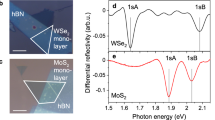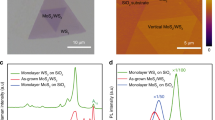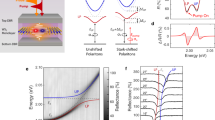Abstract
Charge carriers in two-dimensional transition metal dichalcogenides (TMDs), such as WSe2, have their spin and valley-pseudospin locked into an optically addressable index that is proposed as a basis for future information processing1,2. The manipulation of this spin–valley index, which carries a magnetic moment3, requires tuning its energy. This is typically achieved through an external magnetic field (B), which is practically cumbersome. However, the valley-contrasting optical Stark effect achieves valley control without B, but requires large incident powers4,5. Thus, other efficient routes to control the spin–valley index are desirable. Here we show that many-body interactions among interlayer excitons (IXs) in a WSe2/MoSe2 heterobilayer (HBL) induce a steady-state valley Zeeman splitting that corresponds to B ≈ 6 T. This anomalous splitting, present at incident powers as low as microwatts, increases with power and is able to enhance, suppress or even flip the sign of a B-induced splitting. Moreover, the g-factor of valley Zeeman splitting can be tuned by ~30% with incident power. In addition to valleytronics, our results could prove helpful to achieve optical non-reciprocity using two-dimensional materials.
This is a preview of subscription content, access via your institution
Access options
Access Nature and 54 other Nature Portfolio journals
Get Nature+, our best-value online-access subscription
$29.99 / 30 days
cancel any time
Subscribe to this journal
Receive 12 print issues and online access
$259.00 per year
only $21.58 per issue
Buy this article
- Purchase on Springer Link
- Instant access to full article PDF
Prices may be subject to local taxes which are calculated during checkout




Similar content being viewed by others
Data availability
The authors declare that the data supporting the findings of this study are available within the paper, Supplementary Information and Source Data. Extra data are available from the corresponding authors upon request. Source data are provided with this paper.
References
Wang, G. et al. Colloquium: excitons in atomically thin transition metal dichalcogenides. Rev. Mod. Phys. 90, 021001 (2018).
Xiao, D., Liu, G.-B., Feng, W., Xu, X. & Yao, W. Coupled spin and valley physics in monolayers of MoS2 and other group-VI dichalcogenides. Phys. Rev. Lett. 108, 196802 (2012).
Xiao, D., Yao, W. & Niu, Q. Valley-contrasting physics in graphene: magnetic moment and topological transport. Phys. Rev. Lett. 99, 236809 (2007).
Kim, J. et al. Ultrafast generation of pseudo-magnetic field for valley excitons in WSe2 monolayers. Science 346, 1205–1208 (2014).
Sie, E. J. et al. Valley-selective optical stark effect in monolayer WS2. Nat. Mater. 14, 290–294 (2015).
Srivastava, A. et al. Valley Zeeman effect in elementary optical excitations of monolayer WSe2. Nat. Phys. 11, 141–147 (2015).
Aivazian, G. et al. Magnetic control of valley pseudospin in monolayer WSe2. Nat. Phys. 11, 148–152 (2015).
Li, Y. et al. Valley splitting and polarization by the Zeeman effect in monolayer MoSe2. Phys. Rev. Lett. 113, 266804 (2014).
MacNeill, D. et al. Breaking of valley degeneracy by magnetic field in monolayer MoSe2. Phys. Rev. Lett. 114, 037401 (2015).
Nagler, P. et al. Giant magnetic splitting inducing near-unity valley polarization in van der Waals heterostructures. Nat. Commun. 8, 1551 (2017).
Wang, T. et al. Giant valley-Zeeman splitting from spin-singlet and spin-triplet interlayer excitons in WSe2/MoSe2 heterostructure. Nano Lett. 20, 694–700 (2020).
Ciarrocchi, A. et al. Polarization switching and electrical control of interlayer excitons in two-dimensional van der Waals heterostructures. Nat. Photon. 13, 131–136 (2019).
Zhang, J. et al. Enhancing and controlling valley magnetic response in MoS2/WS2 heterostructures by all-optical route. Nat. Commun. 10, 4226 (2019).
Sanchez, O. L., Ovchinnikov, D., Misra, S., Allain, A. & Kis, A. Valley polarization by spin injection in a light-emitting van der Waals heterojunction. Nano Lett. 16, 5792–5797 (2016).
Zhao, C. et al. Enhanced valley splitting in monolayer WSe2 due to magnetic exchange field. Nat. Nanotechnol. 12, 757 (2017).
Seyler, K. L. et al. Valley manipulation by optically tuning the magnetic proximity effect in WSe2/CrI3 heterostructures. Nano Lett. 18, 3823–3828 (2018).
Li, W., Lu, X., Dubey, S., Devenica, L. & Srivastava, A. Dipolar interactions between localized interlayer excitons in van der Waals heterostructures. Nat. Mater. 19, 624–629 (2020).
Kremser, M. et al. Discrete interactions between a few interlayer excitons trapped at a MoSe2–WSe2 heterointerface. npj 2D Mater. Appl. 4, 8 (2020).
Rivera, P. et al. Valley-polarized exciton dynamics in a 2D semiconductor heterostructure. Science 351, 688–691 (2016).
Laikhtman, B. & Rapaport, R. Exciton correlations in coupled quantum wells and their luminescence blue shift. Phys. Rev. B 80, 195313 (2009).
Viña, L. et al. Spin splitting in a polarized quasi-two-dimensional exciton gas. Phys. Rev. B 54, R8317 (1996).
Amand, T. et al. Spin relaxation in polarized interacting exciton gas in quantum wells. Phys. Rev. B 55, 9880 (1997).
Ciuti, C., Savona, V., Piermarocchi, C., Quattropani, A. & Schwendimann, P. Role of the exchange of carriers in elastic exciton–exciton scattering in quantum wells. Phys. Rev. B 58, 7926 (1998).
Hong, X. et al. Ultrafast charge transfer in atomically thin MoS2/WS2 heterostructures. Nat. Nanotechnol. 9, 682 (2014).
Zhu, H. et al. Interfacial charge transfer circumventing momentum mismatch at two-dimensional van der Waals heterojunctions. Nano Lett. 17, 3591–3598 (2017).
Tran, K. et al. Evidence for moiré excitons in van der Waals heterostructures. Nature 567, 71–75 (2019).
Jiang, C. et al. Optical spin pumping induced pseudomagnetic field in two-dimensional heterostructures. Phys. Rev. B 98, 241410 (2018).
Tan, L. B. et al. Interacting polaron–polaritons. Phys. Rev. X 10, 021011 (2020).
Back, P., Zeytinoglu, S., Ijaz, A., Kroner, M. & Imamoğlu, A. Realization of an electrically tunable narrow-bandwidth atomically thin mirror using monolayer MoSe2. Phys. Rev. Lett. 120, 037401 (2018).
Scuri, G. et al. Large excitonic reflectivity of monolayer MoSe2 encapsulated in hexagonal boron nitride. Phys. Rev. Lett. 120, 037402 (2018).
Barachati, F. et al. Interacting polariton fluids in a monolayer of tungsten disulfide. Nat. Nanotechnol. 13, 906–909 (2018).
Wang, G. et al. Magneto-optics in transition metal diselenide monolayers. 2D Mater. 2, 034002 (2015).
Stier, A. V., McCreary, K. M., Jonker, B. T., Kono, J. & Crooker, S. A. Exciton diamagnetic shifts and valley Zeeman effects in monolayer WS2 and MoS2 to 65 Tesla. Nat. Commun. 7, 10643 (2016).
Lyons, T. P. et al. The valley Zeeman effect in inter- and intra-valley trions in monolayer WSe2. Nat. Commun. 10, 2330 (2019).
Wang, Z., Mak, K. F. & Shan, J. Strongly interaction-enhanced valley magnetic response in monolayer WSe2. Phys. Rev. Lett. 120, 066402 (2018).
Smoleński, T. et al. Tuning valley polarization in a WSe2 monolayer with a tiny magnetic field. Phys. Rev. X 6, 021024 (2016).
Jiang, C. et al. Microsecond dark-exciton valley polarization memory in two-dimensional heterostructures. Nat. Commun. 9, 753 (2018).
Wang, Z. et al. Evidence of high-temperature exciton condensation in two-dimensional atomic double layers. Nature 574, 76–80 (2019).
Tang, Y. et al. Simulation of Hubbard model physics in WSe2/WS2 moiré superlattices. Nature 579, 353–358 (2020).
Regan, E. C. et al. Mott and generalized Wigner crystal states in WSe2/WS2 moiré superlattices. Nature 579, 359–363 (2020).
Shimazaki, Y. et al. Strongly correlated electrons and hybrid excitons in a moiré heterostructure. Nature 580, 472–477 (2020).
Acknowledgements
We acknowledge many enlightening discussions with A. Imamoğlu. A.S. acknowledges support from the NSF through the EFRI program, grant no. EFMA-1741691, and from NSF DMR award no. 1905809.
Author information
Authors and Affiliations
Contributions
W.L., X.L. and J.W. contributed equally to this work. A.S., W.L. and X.L. conceived the project. W.L., X.L. and J.W. carried out the measurements. J.W. prepared the samples. A.S. supervised the project. All the authors were involved in the analysis of the experimental data and contributed extensively to this work.
Corresponding author
Ethics declarations
Competing interests
The authors declare no competing interests.
Additional information
Peer review information
Nature Nanotechnology thanks the anonymous reviewers for their contribution to the peer review of this work.
Publisher’s note Springer Nature remains neutral with regard to jurisdictional claims in published maps and institutional affiliations.
Supplementary information
Supplementary Information
Supplementary Notes 1–7 and Figs. 1–14.
Source data
Source Data Fig. 1
Numerical data used to generate graphs in Fig. 1.
Source Data Fig. 2
Numerical data used to generate graphs in Fig. 2.
Source Data Fig. 3
Numerical data used to generate graphs in Fig. 3.
Source Data Fig. 4
Numerical data used to generate graphs in Fig. 4.
Rights and permissions
About this article
Cite this article
Li, W., Lu, X., Wu, J. et al. Optical control of the valley Zeeman effect through many-exciton interactions. Nat. Nanotechnol. 16, 148–152 (2021). https://doi.org/10.1038/s41565-020-00804-0
Received:
Accepted:
Published:
Issue Date:
DOI: https://doi.org/10.1038/s41565-020-00804-0
This article is cited by
-
Localisation-to-delocalisation transition of moiré excitons in WSe2/MoSe2 heterostructures
Nature Communications (2024)
-
Excitonic devices based on two-dimensional transition metal dichalcogenides van der Waals heterostructures
Frontiers of Chemical Science and Engineering (2024)
-
Quadrupolar–dipolar excitonic transition in a tunnel-coupled van der Waals heterotrilayer
Nature Materials (2023)
-
Excitonic transport driven by repulsive dipolar interaction in a van der Waals heterostructure
Nature Photonics (2022)
-
Light-induced ferromagnetism in moiré superlattices
Nature (2022)



